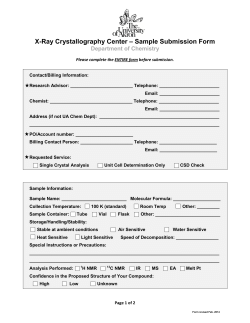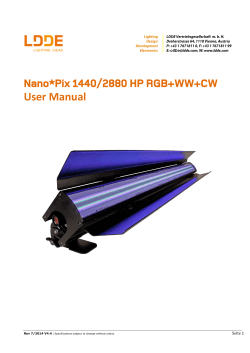
Pigment Analysis: Sample collection and measurement techniques
Pigment Analysis: Sample collection
and measurement techniques
Crystal S. Thomas
Science Systems and Applications, Inc.
NASA Goddard Space Flight Center
Greenbelt, MD 20771 USA
crystal.s.thomas@nasa.gov
410-443-1896
21 October 2013
Crystal S Thomas
NANO Workshop, 21Oct – 24Oct 2013
Outline
• Field sampling
• Pigment measurement techniques
– Fluorometry
– Spectrophotometry
– Chromatography
• Choosing the appropriate technique
21 October 2013
Crystal S Thomas
NANO Workshop, 21Oct – 24Oct 2013
Field sampling
Important considerations
1. Recording information/labeling
2. Adequate amount of water filtered (depends on
analysis technique)
3. Replicate sample collection
4. Storage/transport of samples
21 October 2013
Crystal S Thomas
NANO Workshop, 21Oct – 24Oct 2013
Sample filtration
• Log sheets
– Record date, time, station, sample type, replicate number,
latitude/longitude, filtration volume
– Any relevant notes-record any loss of volume, anomalous
issues, something interesting
• Replicate filters-at least 5% (more for new groups new
to sampling or sites expected to not be homogenous)
• If collecting water from the pump off side of ship,
record the time and location (lat/long) when starting
the collection and when water collection is complete.
Record the depth the water was taken from by looking
at the markings on the tubing set up in meters).
21 October 2013
Crystal S Thomas
NANO Workshop, 21Oct – 24Oct 2013
Sample filtration (cont.)
1.
2.
3.
4.
5.
6.
7.
8.
Set up three polysulfone filter cups/stems with 25mm GF/F filters.
Rinse out amber bottles and graduated cylinder 3 times with 100-200ml of collected
seawater.
Measure the required seawater volume with a graduated cylinder and pour into
appropriate-sized amber bottle. Record volume on log sheet.
Invert amber bottle onto filter cup (carefully and quickly to minimize spillage).
Repeat 3 and 4 until color can be seen on the filter.
When the appropriate volume has been filtered, rinse the filter cup with filtered
seawater. Do not let filter run dry under vacuum. Close valve when last few mls
are running through the filter.
Remove filter from stem with forceps. Place on Kim wipe, fold in half (biomass
side in) and blot gently with Kim wipe to remove excess water. Place in foil packet,
cryovial, or histoprep for storage.
Label clearly with permanent marker (black preferred), being careful not to pierce
the foil and contaminate the sample with ink. Foil packets can be pre-labeled with
marker or printed labels. Store in liquid nitrogen.
21 October 2013
Crystal S Thomas
NANO Workshop, 21Oct – 24Oct 2013
Sample storage/transport
• Clear, consistent labeling
– Heavy duty foil, quality permanent markers
• Liquid nitrogen for storage-if liquid nitrogen is
not available, an ultra-cold (-80C) freezer can be
used
• Liquid nitrogen for transport-if liquid nitrogen is
not available, dry ice can be used
– Samples should be in airtight container
21 October 2013
Crystal S Thomas
NANO Workshop, 21Oct – 24Oct 2013
Fluorometry
• Based on pigment fluorescence
• Useful for chlorophyll measurement (primarily
chlorophyll a)
21 October 2013
Crystal S Thomas
NANO Workshop, 21Oct – 24Oct 2013
Spectrophotometry
• Based on pigment absorbance
• Used to determine concentration of pigment
standards as well as sample analysis
• Can measure many different pigments (pure)
– When used to analyze samples, primarily used for
chlorophyll a, b, c
– Multivariate approach to obtain carotenoid data in
samples
21 October 2013
Crystal S Thomas
NANO Workshop, 21Oct – 24Oct 2013
Chromatography
• Separation procedure rather
than a measurement procedure
• Relies on chemical reactions to
physically separate pigments
• Can use absorbance and/or fluorescence for
measurement of pigments
21 October 2013
Crystal S Thomas
NANO Workshop, 21Oct – 24Oct 2013
Chromatography
21 October 2013
Crystal S Thomas
NANO Workshop, 21Oct – 24Oct 2013
Chromatography
21 October 2013
Crystal S Thomas
NANO Workshop, 21Oct – 24Oct 2013
Fluorometry
advantages/disadvantages
• Advantages
• Disadvantages
–
–
–
–
–
Sensitive
Simple calibration
Fast results
Easy to use in situ
Instruments can be taken
in the field
– Lots of historic data to
which to compare
21 October 2013
Crystal S Thomas
– Only get chlorophyll a
products
– Other pigments can
interfere with
measurement
NANO Workshop, 21Oct – 24Oct 2013
Spectrophotometry
advantages/disadvantages
• Advantages
• Disadvantages
– Results for more
pigments
– Fast results
– Measurement is
independent of other
measurements
21 October 2013
Crystal S Thomas
– Not as sensitive
– Relatively narrow linear
range
– To obtain carotenoid
data, have to have
knowledge of pigments
expected to be present
NANO Workshop, 21Oct – 24Oct 2013
Chromatography
advantages/disadvantages
• Advantages
• Disadvantages
– Results for many
pigments
– Separation can be tailored
– Capable of providing
physical separation of DV
and MV chlorophylls
21 October 2013
Crystal S Thomas
– More complicated
calibration, separation
– Requires more expertise
– More expensive
•
•
•
•
Equipment
Training
Pigment standards
Laborataory materials
NANO Workshop, 21Oct – 24Oct 2013
Define research goals
• Have to have a clear idea of research goals in order to
determine the most appropriate method
• Are you mainly interested in chlorophyll a?
• Are you going to use accessory pigment data? Will
someone in the future want to use accessory pigment
data?
• What kind of waters are you working in? What kind of
detection limit(s) will you need?
• Are you conducting more “research” or “production”?
21 October 2013
Crystal S Thomas
NANO Workshop, 21Oct – 24Oct 2013
Conclusions
• There is no one “best” analysis technique
• A robust laboratory assessment would include a
combination of techniques
21 October 2013
Crystal S Thomas
NANO Workshop, 21Oct – 24Oct 2013
Resources
NASA/TM–2010–215857
Roy, S., C.A. Llewellyn, E.S. Egeland, and
G. Johnson, 2011: Phytoplankton Pigments:
Characterization, Chemotaxonmy, and Applications
in Oceanography. Cambridge University Press, 845 pp.
The Fourth SeaWiFS HPLC Analysis Round-Robin
Experiment (SeaHARRE-4)
Stanford B. Hooker, Crystal S. Thomas, Laurie Van Heukelem, Louise Schlüter, Mary E. Russ,
Joséphine Ras, Hervé Claustre, Lesley Clementson, Elisabetta Canuti, Jean-François Berthon,
Jason Perl, Claire Nomandeau, John Cullen, Markus Kienast, and James L. Pinckney
December 2010
NASA/TM–2005–212785
The Second SeaWiFS HPLC Analysis Round-Robin
Experiment (SeaHARRE-2)
Stanford B. Hooker, Laurie Van Heukelem, Crystal S. Thomas, Hervé Claustre, Joséphine Ras,
Ray Barlow, Heather Sessions, Louise Schlüter, Jason Perl, Charles Trees, Venetia Stuart, Erica Head,
Lesley Clementson, James Fishwick, Carole Llewellyn, and James Aiken
Snyder, L.R., J.J. Kirkland, J.W. Dolan, 2010:
Introduction to Modern Liquid Chromatography.
John Wiley and Sons Publishing, 960pp.
August 2005
http://oceancolor.gsfc.nasa.gov/HPLC/
21 October 2013
Crystal S Thomas
NANO Workshop, 21Oct – 24Oct 2013
Resources
•
•
•
•
•
•
•
Roy, S., C.A. Llewellyn, E.S. Egeland, and G. Johnson, 2011: Phytoplankton Pigments: Characterization, Chemotaxonmy, and
Applications in Oceanography. Cambridge University Press, 845 pp.
Snyder, L.R., J.J. Kirkland, J.W. Dolan, 2010: Introduction to Modern Liquid Chromatography. John Wiley and Sons Publishing,
960pp.
Hooker, S.B., H. Claustre, J. Ras, L. Van Heukelem, J-F. Berthon, C. Targa, D. van der Linde, R. Barlow, and H. Sessions, 2000:
The First SeaWiFS HPLC Analysis Round-Robin Experiment (SeaHARRE-1). NASA Tech. Memo. 2000–206892, Vol. 14, S.B.
Hooker and E.R. Firestone, Eds., NASA Goddard Space Flight Center, Greenbelt, Maryland, 42 pp.
Hooker, S.B.,L. Van Heukelem, C.S. Thomas, H. Claustre, J. Ras, L. Schl¨uter, J. Perl, C. Trees, V. Stuart, E. Head, R. Barlow, H.
Sessions, L. Clementson, J. Fishwick, C. Llewellyn, and J. Aiken, 2005: The Second SeaWiFS HPLC Analysis Round-Robin
Experiment (SeaHARRE-2). NASA Tech. Memo. 2005–212785, NASA Goddard Space Flight Center, Greenbelt, Maryland, 112
pp.
Hooker, S.B., L. Van Heukelem, C.S. Thomas, H. Claustre, J. Ras, L. Schluter, L. Clementson, D. van der Linde, E. Eker-Develi,
J-F. Berthon, R. Barlow, H. Sessions, H. Ismail, and J. Perl, 2009: The Third SeaWiFS HPLC Analysis Round-Robin Experiment
(SeaHARRE-3). NASA Tech. Memo. 2009{215849, NASA Goddard Space Flight Center, Greenbelt, Maryland, 97 pp.
Hooker, S.B., C.S. Thomas, L. Van Heukelem, L. Schluter, M.E.Russ, J. Ras, H. Claustre, L. Clementson, E. Canuti, J-F. Berthon,
J. Perl, C. Normandeau, J. Cullen, M. Kienast, and J.L. Pinckney, 2010: The Fourth SeaWiFS HPLC Analysis Round-Robin
Experiment (SeaHARRE-4). NASA Tech. Memo. 2010–215857, NASA Goddard Space Flight Center, Greenbelt, Maryland, 74 pp.
Hooker, S.B., L. Clementson, C.S. Thomas, L. Schluter, M. Allerup, J. Ras, H. Claustre, C. Normandeau, J. Cullen, M. Kienast, W.
Kozlowski, M. Vernet, S. Chakraborty, S. Lohrenz, M. Tuel, D. Redalje, P. Cartaxana, C. Mendes, V. Brotas, S.G.P. Matondkar,
S.G. Parab, A. Neeley, and E.E. Egeland, 2012: The Fifth SeaWiFS HPLC Analysis Round-Robin Experiment (SeaHARRE-5).
NASA Tech. Memo. 2012–217503, NASA Goddard Space Flight Center, Greenbelt, Maryland, 98 pp.
© Copyright 2025
















